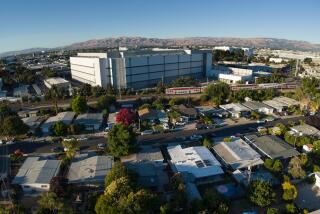Bloom Energy unveils plan to make fuel-cell technology more affordable
- Share via
Looking to boost the use of its clean electricity technology, Bay Area firm Bloom Energy is offering businesses an economical way to power their buildings with its fuel cells.
The company’s so-called Bloom Box energy servers can cost as much as $800,000 each — an investment too rich for many businesses.
Under a new program announced Thursday, customers can skip the hefty upfront cost of buying the units and instead just purchase the power under a 10-year contract with Bloom. The Sunnyvale, Calif., company will own and maintain the fuel cells.
Big electricity users, including Wal-Mart Stores Inc., Coca-Cola Co. and Staples Inc., have already purchased some of Bloom’s refrigerator-sized fuel cells. Those three companies said Thursday that they would deploy more of the units under the leasing plan.
In addition, Caltech said it had signed a power purchase agreement with Bloom and planned to install 20 boxes. Kaiser Permanente has ordered 4 megawatts of Bloom-produced power, requiring 40 boxes.
Some experts said power-purchase agreements could help spread the use of fuel cell technology, much as they have in the solar industry, by lowering the upfront costs for users.
“Anything you can do to remove the barriers to adoption is a really important step forward,” said Ruth Cox, executive director of the Fuel Cell and Hydrogen Energy Assn. “We’re already seeing a lot more momentum with fuel cells, and even more companies will take advantage with an opportunity like this.”
The Bloom Box takes oxygen from the air and combines it with fuel such as natural gas or biogas in a constant electrochemical process that produces power without combustion.
In the past, fuel cells were seen as expensive and difficult to produce. But with technical breakthroughs, government subsidies and declining prices because of growing adoption, fuel cell companies seem poised for expansion.
Bloom Chief Executive KR Sridhar said the new affordability would help Bloom — which debuted the technology last year to much fanfare — expand to residential customers over the next decade.
“It’s all about flexibility,” he said. “We are a culture of instant gratification. This is a way to get it.”
But unlike other renewable power sources, which generate electricity intermittently and often lock participants into 30-year deals, Bloom executives said fuel cell customers would get a steady supply of energy and immediate utility bill savings of up to 20%.
Roughly 22,000 fuel cells were shipped to customers around the world in 2009, a 40% increase from the year before, according to the International Partnership for Hydrogen and Fuel Cells in the Economy, an international fuel cell advocacy group. The Department of Energy recently set aside $65 million for fuel cell research and development.
More to Read
Inside the business of entertainment
The Wide Shot brings you news, analysis and insights on everything from streaming wars to production — and what it all means for the future.
You may occasionally receive promotional content from the Los Angeles Times.











